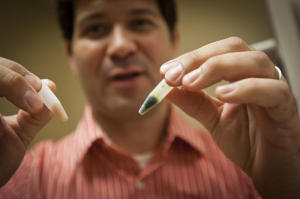摘要: 许多水声生物如海藻和蓝藻能吸收太阳能,分解水分子并释放氢气,这一清洁无碳燃料非常具有市场前景,但该方法还没有成为燃料来源的技术瓶颈是,产物氢气会向其他复合物代谢途径输送,这些代谢通路是机体生长所必需的。美国麻省理工学院生物医学工程中心副主任张曙光发现了一种新方法,利用生物工程酶把生物体的代谢途径切换到产氢模式下,最大化地利用产氢途径,产生更多的氢气。

右边:来自植物的绿色光合膜蛋白 左边:铁氧化还原蛋白,两者共同使用提高氢气产量
Many kinds of algae and cyanobacteria, common water-dwelling microorganisms, are capable of using energy from sunlight to split water molecules and release hydrogen, which holds promise as a clean and carbon-free fuel for the future. One reason this approach hasn’t yet been harnessed for fuel production is that under ordinary circumstances, hydrogen production takes a back seat to the production of compounds that the organisms use to support their own growth.
But Shuguang Zhang, associate director of MIT’s Center for Biomedical Engineering, and postdocs Iftach Yacoby and Sergii Pochekailov, together with colleagues at Tel Aviv University in Israel and the National Renewable Energy Laboratory in Colorado, have found a way to use bioengineered proteins to flip this preference, allowing more hydrogen to be produced.
“The algae are really not interested in producing hydrogen, they want to produce sugar,” Yacoby says — the sugar is what they need for their own survival, and the hydrogen is just a byproduct. But a multitasking enzyme, introduced into the liquid where the algae are at work, both suppresses the sugar production and redirects the organisms’ energies into hydrogen production. The work is described in a paper being published online this week in the Proceedings of the National Academy of Sciences, and was supported in part by a European Molecular Biology Organization postdoctoral fellowship, the Yang Trust Fund and the U.S. Department of Energy’s National Renewable Energy Laboratory.
Adding the bioengineered enzyme increases the rate of algal hydrogen production by about 400 percent, Yacoby says. The sugar production is suppressed but not eliminated, he explains, because “if it went to zero, it would kill the organism.”
The research demonstrates for the first time how the two processes carried out by algae compete with each other; it also shows how that competition could be modified to favor hydrogen production in a laboratory environment. Zhang and Yacoby plan to continue developing the system to increase its efficiency of hydrogen production.
“It’s one step closer to an industrial process,” Zhang says. “First, you have to understand the science” — which has been achieved through this experimental work. Now, developing it further — through refinements to produce a viable commercial system for hydrogen-fuel manufacturing — is “a matter of time and money,” Zhang says.
Ultimately, such a system could be used to produce hydrogen on a large scale using water and sunlight. The hydrogen could be used directly to generate electricity in a fuel cell or to power a vehicle, or could be combined with carbon dioxide to make methane or other fuels in a renewable, carbon-neutral way, the researchers say.
Bengt Nordén, chair of the physical chemistry department at the Chalmers University of Technology in Gothenburg, Sweden, says, “The results are convincing, although it is difficult to judge, at this stage, how useful this system could be for practical energy purposes.”
Nordén adds, “Hydrogen will no doubt be the future’s fuel,” either in pure form or combined to make methane. This particular method of making hydrogen, he says, “is a both simple and environmentally friendly bio-inspired system.”
In the long run, “the only viable way to produce renewable energy is to use the sun, [either] to make electricity or in a biochemical reaction to produce hydrogen,” Yacoby says. “I believe there is no one solution,” he adds, but rather many different approaches depending on the location and the end uses.
This particular approach, he says, is simple enough that it has promise “not just in industrialized countries, but in developing countries as well” as a source of inexpensive fuel. The algae needed for the process exist everywhere on Earth, and there are no toxic materials involved in any part of the process, he says.
“The beauty is in its simplicity,” he says.







